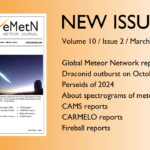Roberto Gorelli points our attention at a recently published meteor related paper.
A fireball and potentially hazardous binary near-Earth asteroid (164121) 2003 YT1
This paper has been submitted for publication to Astronomical Journal by Toshihiro Kasuga, Mikiya Sato, Masayoshi Ueda, Yasunori Fujiwara, Chie Tsuchiya, and Jun-ichi Watanabe.
Abstract: We present a fireball detected in the night sky over Kyoto, Japan on UT 2017 April 28 at 15h 58m 19s by the SonotaCo Network. The absolute visual magnitude is Mv=−4.10±0.42 mag. Luminous light curves obtain a meteoroid mass m=29±1 g, corresponding to the size as=2.7±0.1 cm. Orbital similarity assessed by D-criterions (cf. DSH=0.0079) has identified a likely parent, the binary near-Earth asteroid (164121) 2003 YT1. The suggested binary formation process is a YORP-driven rotational disintegration (Pravec & Harris 2007). The asynchronous state indicates the age of < 104 yr, near or shorter than the upper limit to meteoroid stream lifetime. We examine potential dust production mechanisms for the asteroid, including rotational instability, resurfacing, impact, photoionization,radiation pressure sweeping, thermal fracture and sublimation of ice. We find some of them capable of producing the meteoroid-scale particles. Rotational instability is presumed to cause mass shedding, in consideration of the recent precedents (e.g. asteroid (6478) Gault), possibly releasing mm-cm scale dust particles. Impacts by micrometeorites with size ≃ 1 mm could be a trigger for ejecting the cm-sized particles. Radiation pressure can sweep out the mm-sized dust particles, while not sufficient for the cm-sized. For the other mechanisms, unprovable or unidentified. The feasibility in the parental aspect of 2003 YT1 is somewhat reconciled with the fireball observation, yielding an insight into how we approach potentially hazardous objects.
You can download this paper for free: https://arxiv.org/pdf/1910.06527.pdf (36 pages).
Older meteor library news:
2019
- Spectral and orbital survey of medium-sized meteoroids, by Pavol Matlovic, Juraj Tóth, Regina Rudawska, Leonard Kornoš and Adriana Pisarcíková. (7 August 2019).
- Rising from Ashes or Dying Flash? Mega Outburst of Small Comet 289P/Blanpain in 2013, by Quanzhi Ye (叶泉志) and David L. Clark. (19 June 2019).
- Discovery of a Meteor of Interstellar Origin, by Amir Siraj and Abraham Loeb. (10 June 2019).
- A Mathematical Model for Simulating Meteor Showers, by M. Cardinot and A. Namen. (4 June 2019).
- The 2019 Taurid resonant swarm: prospects for ground detection of small NEOs, by David Clark, Paul Wiegert and Peter G. Brown. (28 May 2019).
- Analysis of the June 2, 2016 bolide event over Arizona, by Csaba Palotai, Ramanakumar Sankar, Dwayne L. Free, J. Andreas Howell, Elena Botella and Daniel Batcheldor. (25 May 2019).
- Identifying Interstellar Objects Trapped in the Solar System through Their Orbital Parameters, by Amir Siraj and Abraham Loeb. (5 May 2019).
- Meteor Shower Modeling: Past and Future Draconid Outbursts, by A. Egal, P. Wiegert, P. G. Brown, D. E. Moser, M. Campbell-Brown, A. Moorhead, S. Ehlert and N. Moticska. (1 May 2019).
- Meteoroid structure and fragmentation, by M. D. Campbell-Brown. (24 March 2019).
- Solar cycle variation in radar meteor rates, by M. D. Campbell-Brown. (26 February 2019).
- A New Meteoroid Model, by Valeri V. Dikarev, Eberhard Grün, William J. Baggaley, David P. Galligan, Markus Landgraf, Rüdiger Jehn. (12 February 2019).
- Lunar impacts, by Costantino Sigismondi. (12 February 2019).
- Lunar impact flashes, by C. Avdellidou and J. Vaubaillon. (10 February 2019).
- The Geminid parent body: (3200) Phaethon, by Patrick A. Taylor, Edgard G. Rivera-Valentín, Lance A.M. Benner, Sean E. Marshall, Anne K. Virkki, Flaviane C.F. Venditti, Luisa F. Zambrano-Marin, Sriram S. Bhiravarasu, Betzaida Aponte-Hernandez, Carolina Rodriguez Sanchez-Vahamonde and Jon D. Giorgini. (10 February 2019).
- Sun approaching asteroids and meteor streams, by Quanzhi Ye and Mikael Granvik. (10 February 2019).
2018
- Waiting to make an impact: A probable excess of near-Earth asteroids in 2018 LA-like orbits, by C. de la Fuente Marcos and R. de la Fuente Marcos. (18 December 2018).
- What mechanisms dominate the activity of Geminid Parent (3200) Phaethon?, by LiangLiang Yu, Wing-Huen Ip and Tilman Spohn. (6 November 2018).
- The Draconid meteoroid stream 2018: prospects for satellite impact detection, by Auriane Egal, Paul Wiegert, Peter G. Brown, Danielle E. Moser, Althea V. Moorhead and William J. Cooke (21 September 2018).
- Modeling the measurement accuracy of pre-atmosphere velocities of meteoroids, by Denis Vida, Peter G. Brown and Margaret Campbell-Brown (15 July 2018).
2017
- The Mayas and Eta Aquariids in AD 250-909, by J.H. Kinsman and D.J. Asher (31 July 2017).


